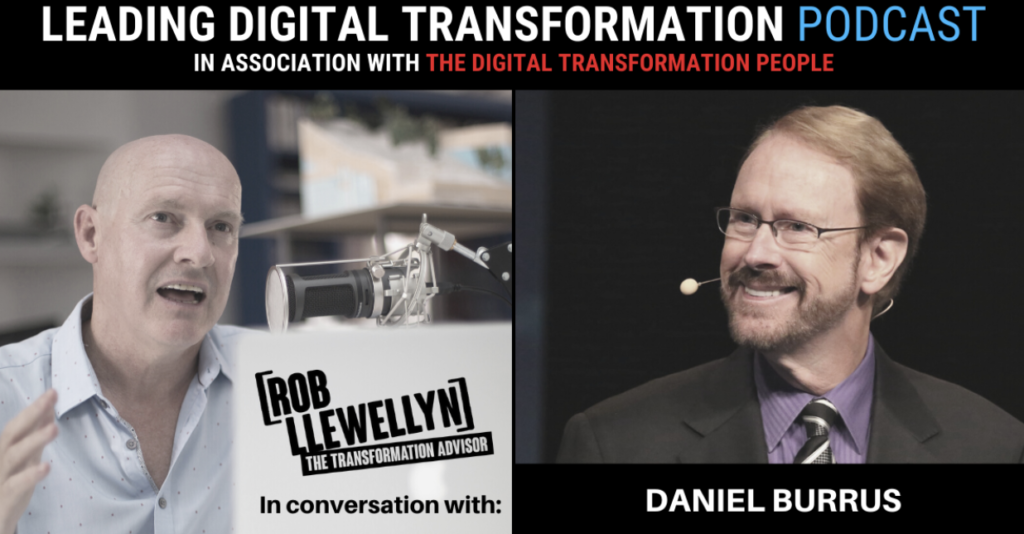‘Leading Digital Transformation’ is a weekly podcast series in association with The Digital Transformation People and Rob Llewellyn digital transformation advisor and founder of CXO Transform.
During this series, Rob interviews experienced practitioners, authors and thought leaders whose stories and experiences provide valuable insights for digital transformation success.

In this episode, Rob is by joined Daniel Burrus, futurist, keynote speaker and author of 6 best selling books. During the course of 3 decades, Daniel has established a worldwide reputation for accurately predicting the future of technological change and its impact on the world of business. He has helped hundreds of clients identify game-changing opportunities and develop successful competitive business strategies based on his Hard Trend methodology and Anticipatory Organization Model which he presents in his latest book “The Anticipatory Organization”.
“In today’s world, you’re either going to be the disrupted or the disruptor. And if you are merely an agile organisation reacting quickly after disruption disrupts or after a problem occurs, disruption is inevitable. And you’re going to have to learn how to react fast to that. But if you learn how to separate the hard trends from the soft trends, the future facts from the future possibilities, the future assumptions, what you find is that disruption becomes a choice.”
Listen here and read the full transcript below.
Transcript
Rob Llewellyn [00:00:20] I’m joined today by Daniel Burrus, author of the book “The Anticipatory Organization“. Daniel is considered one of the world’s leading futurists on global trends and innovation. The New York Times has referred to him as one of the top three business gurus in the highest demand as a speaker. He says that the anticipatory leaders of our world understand that we’re at a unique point in human history, filled with waves of disruption and opportunity. To hear more about that, let’s jump into the interview with Daniel. Daniel, welcome.
Daniel Burrus [00:00:56] Hey, it’s a pleasure to be with you.
Rob Llewellyn [00:00:59] Great to have you here. Daniel, there’s an old saying that there are only two certainties about the future and that’s death and taxes. How can people learn how to anticipate change and disruption in a world which is now really filled with increasing uncertainty?
Daniel Burrus [00:01:16] Well, you know, it is true. Most people do feel that it’s impossible to predict the future and that really causes a lot of problems, because what I’ve done over the last 35 years has helped companies and organisations and leaders all over the world realise how much certainty and how predictable a great part of the future actually is and the advantage in being able to do that. For example, could an astronomer accurately predict in the year 2035 in March the exact moment we’ll have a full moon? And the answer is, of course, they can. Do people in agriculture know when they’re going to be planting versus harvesting? Well, of course, they do. And the stock market goes up, but it doesn’t go up forever. It will go down. And by the way, it won’t go down forever. It’ll go back up again. And that we have biological cycles of life and so on. We’ve got weather cycles. We’ve got all these different cycles. And that is – a matter of fact, there’s over 500 known cycles that allow you to get a handle on the future.
However, what I want to talk about here as it relates to transformation and disruption is another kind of change that was very slow in the past. But now it’s coming to its exponential speed. And I would call that linear in that it’s not a cycle. Once this happens, it’s not going back slash exponential, which means it’s being driven by technology that is accelerating at an exponential level. In other words, 2 becomes 4 becomes 8. So let me give an example. Once you get a smartphone, you’re not going back to a dumb phone. Once the people in India get refrigeration for their home, they’re not going to say we don’t need refrigeration. And once the people in China park their bicycle and get a car, it’s going to be hard to give up the car and go back to the bike. So there is amazing amounts of predictability in terms of opportunities and what you can see and problems that you can pre-solve. I’m going to cut right to the chase here and just kind of give you the science behind it. I’ve started six companies over the years, but before that, I taught biology and physics and I’m sharing that with our listeners so that everyone knows, you know, this is a scientific-based methodology I’m going to share with you on how to be anticipatory.
It’s really looking at trends in a new and powerful way to see and find certainty. As a matter of fact, just a little side note on certainty: strategy, whether it’s personal or professional, based on uncertainty, has high risk. On the other end, strategy, whether it’s personal or professional, based on certainty, actually has low risk. Actually, the risk is in not taking action when you have certainty and certainty gives you the confidence to make a bold move. If you’re uncertain, you’re timid. You’re shy. You don’t make bold moves. But when you have confidence, you will, and that’s how you as a leader can engage your people when they have high levels of certainty. So going back to trends, you know, there’s no shortage of trends. The problem is which ones are going to happen, which ones aren’t. And I’ve kind of over the last 35 years solved that with my seven best-selling books and thousands of articles, and so on. And that is, all trends can be divided into one of two categories. They’re either a hard trend, which is based on a future fact that will happen. It’s not an if or a maybe, it’s a future fact. It will happen. And the advantage of a hard trend is it lets you see disruption before it disrupts and that turns disruption into a choice. And I know we’ll talk a little bit more about that later. The other type of trend is a soft trend. And a soft trend is based on an assumption about the future. Often it’s seen as a future fact, but actually it’s not. It’s an assumption that may or may not happen. So both have advantages. The advantage of a soft trend is if you don’t like it, you can change it. So by separating those two, you have a way of finding certainty again in an uncertain world. And one last comment. Then I’ll let you ask some more questions!
Over the last, I would say twelve, fifteen years at least, I have been surveying live every audience that I speak to. And for quite a bit of that time, I was giving between seventy-five and a hundred speeches a year globally. Last time I was in Beijing there were 14000 business leaders from 30 countries in the audience. So even big ones like that, I have surveyed and got their information back. And what I’m asking them is to give me a one hard trend future fact they know will impact their business or their customer and a related opportunity. And over the decades, I have collected not 20 certainties, not 30, but thousands of future facts. So to think death and taxes, is it? Well, what we’re going to do in this podcast is show you that’s not the case at all!
Rob Llewellyn [00:06:35] You mentioned the word disruption. And of course, as we know, a lot of leaders are now fearful of disruption and what it can do to their business, the product line, not to mention their careers. So how can we all become better at avoiding disruption?
Daniel Burrus [00:06:52] Well, I’m going to flip this on you. In my last book, “The Anticipatory Organization” and in the book before that “Flash Foresight”, I was sharing a very powerful strategy that says opposites work better. And so if you look in the opposite direction or you take a concept and reverse it, you often find the bigger opportunity. So now I’m going to do that with the word disruption and how can we avoid it? And I’m going to flip it on you. I want everyone listening to this to become a positive disruptor. I want you to be the disruptor. And here’s why. In today’s world, you’re either going to be the disrupted or the disruptor. And if you are merely an agile organisation reacting quickly after disruption disrupts or after a problem occurs, disruption is inevitable. And you’re going to have to learn how to react fast to that. But if you learn how to separate the hard trends from the soft trends, the future facts from the future possibilities, the future assumptions, what you find is that disruption becomes a choice. And so I want us to be the disruptor because if you’re not, you know what? You’re going to be disrupted. And I used a phrase in there that I think is really important for us to understand. I said, I want you to become a “positive” disruptor. So let’s just talk about disruption.
Most people listening to this, most people all over the world think disruption is negative. Matter of fact, you framed up the question in that way. You know, how are we going to avoid disruption? But let’s take a look at one of the large global companies like Amazon. Does the CEO of Amazon, Jeff Bezos, does he see disruption as negative? No, he doesn’t see it as negative at all. It’s all the people he’s disrupting that see it as negative. Actually, it’s quite positive for him. And when Apple launched the first iPhone or the first iPad, you know, did they see disruption as negative? No, they were the disruptor. It was all the people they were disrupting like BlackBerry and others that saw it as negative. By the way, BlackBerry could have seen that coming. But they were too busy doing what they always do. Just like, why didn’t the cab driver think of Uber? And that is they were too busy being cab drivers and didn’t step back and become anticipatory based on the direction technology is going. The future facts that were right there in front of them to see it. So positive disruption is asking yourself, “what are the disruptions that need to happen to take the friction out where there is friction, to improve dramatically the customer experience, to redefine and reinvent a product or service to make it more relevant?” Frankly, I think there is no such thing as perfection. I think perfection is a goal, just like an ideal future. You may not be able to get to an ideal. But if you think about it, you might be able to get close. What I’m getting at is everything, everything can be made better. Everything. And I love that. As an entrepreneur who started six companies, I love that because everything can be made better. So what I want us to do is positively disrupt everything. I want you to be the disruptor.
Rob Llewellyn [00:10:17] Now, we’d all like to know what’s next Daniel. And of course, we see a lot of trends out there. Some are right. And some are wrong. In your book, “The Anticipatory Organization”, you describe a method to know which trends will actually happen. Can you tell us a little bit about that?
Daniel Burrus [00:10:35] Yes. So let me get a little bit more on this subject of, again, hard trends and soft trends. First insight I want to give all of us is that a trend, whether it’s hard or soft by itself: I’m bored, who cares? Until you attach an opportunity to it, it will be static. You make a trend come to life when you attach an opportunity. So when it comes to hard trends and being able to be right about the future, there’s three categories and I’m going to show you how opportunities can work here. So there’s only three categories, it’s not that difficult. One of the categories is demographics. For example, you’re in Spain at the moment. I’m in the United States at the moment. We both have an ageing population in both those countries. So as a matter of fact, many countries, not all, but many have ageing populations. China being one. Japan is another and so on. Most of Europe has got an ageing population. And hard trend, baby boomers, as we call them, you know, they’re not going to get younger. They’re going to continue to get older. And that means there are many predictable problems that we could pre-solve if we were anticipatory or if we’re reactionary, we can just let them happen. And there are many amazing opportunities for us that we could innovate around with low risk or we could let someone else do it. Because if it can be done, it will be done. Quick example. There are a lot of rivers and lakes in many countries, in many areas, and a lot of people love to go boating. But as they get older, at some point it gets kind of hard to get in the boat. It gets kind of hard to launch the boat. Maybe you have a grandmother, grandfather that loved a boat that’s in that situation right now or an uncle or something. So why don’t you and I create the “easy launch trailer for seniors”? Now, we did a good job of designing that, would we have a growing market? And that’s very predictable. And all of the countries that have an ageing population, as a matter of fact, we know which countries to sell this in and which countries to not bother with, because we have the numbers, we have the hard trends. We can see it. So once again, you can see opportunities. So I just gave you an example of taking a hard trend, the ageing population in many countries, and then attaching an opportunity to it, in this case boating, and creating a solution that will grow and is very predictable. There are many that you could do like that. Now not to get bogged down, let me give you the other two categories. Second one is and this one will shock most people to hear it: government regulation. Every country, I don’t care where you are on the planet, has regulations of some kind and regulations are not going away. So you might think, well, how can that be tied to a hard trend? Well, once you have a law that is passed, you can see some really great opportunities if you take the time. For example, here in the United States, I’m in California, and in January, there are usually about a thousand new laws that go into a state like California. It’s a big state. So a thousand new laws, by the way, two years ago, there was a new law that came out in California that said that within two years, remember this a law, within two years, all of the reading that kindergartners and first graders, those little kids, have to read half of their reading within two years has to be non-fiction. By the way, right now it’s all fiction. And when you hear something like that, whether you’re in California or anywhere else, you might say to yourself, “What are they doing? Why don’t they work on something important, that’s stupid” and you get all upset. But a young teacher in San Diego who is 27 years old, found out about that law and made three phone calls. She called the Los Angeles School District, the San Francisco School District and the San Diego School District, the three largest in the state. She did well on that one. And she said, you got two years to get half of those books to be non-fiction that you’re sharing with those little kids. If I helped you find the books and got the books to you, would you be interested? And they said “yeah, we didn’t know how we’re going to do that. And it’s a law.” To cut to the chase here. What did she do? She found a built-in customer, created a company, didn’t have to go on a show like Shark Tank to figure out how she’s going to raise money. In other words, she saw the future and took advantage of it, saw an opportunity. So, will we, in all of the countries that are listening to this, will we get more regulation around, let’s say, cybersecurity. The answer is “yes”. And why is that? Because there’s some hard trends at play we can’t ignore. There are some regulations that are debatable. And of course, politics gets in the way and they may or may not happen. Many places like here in the US, health care reform is bogged down. So I say, well, you know, instead of looking at all the things you don’t know, all the things you can’t predict, all the uncertainties, why don’t you look in the other direction of all the things you do know, all the things you can predict and look for those opportunities. The third one I want to give you and I’m spending some time on this because it’s a foundation to our conversation and podcast today, and that is “technology”. And that’s probably the most powerful of all because it lets us do things that were impossible before. We’re doing things today that were impossible just two years ago. And by the way, we’ll be doing things two years from now that are impossible today. What’s interesting is when you learn to use the hard trend methodology, you can see the things we’ll be doing one, two, three, four years from now with certainty and develop the ways that you can profit from them and become the positive disruptor and create solutions for your clients and deliver them at the speed of need, which is very, very powerful. So we’re starting to get 5G rolled out. By the way, is that it? No. We’re going to have 6G, followed by 7G. Matter of fact, I’ve been predicting those different wireless since 1G. So when is 1G coming out? 2G, 3G, 4G and now 5G. I’ve been perfectly accurate on all those and exactly how powerful they would be. You see, it’s predictable and we’re putting more and more in the cloud. Is the cloud getting full? No, we’re going to be putting more and more on the cloud and as a matter of fact, we have more security by being in the cloud than being out of the cloud today, which is again an opposite reverse. So is AI going to get exponentially more powerful and machine learning and all of that? The answer is, well, yes. The key is, what are we going to do to profit from it and what predictable problems can we foresee and pre-solve by being anticipatory instead of waiting to have those problems and then put out fires and crisis manage, which is being reactionary and agile.
Rob Llewellyn [00:17:37] Daniel, one of the latest trends which we see rippling through companies is agility. But in your book, you say that reaching, reacting to problems, digital disruptions, no matter how agile an organisation, isn’t enough. Can you elaborate on that?
Daniel Burrus [00:17:55] Yeah, thanks. I brought up the subject a little bit earlier, but let me get into a little bit more because it’s really important. Most organisations around the world think that to deal with the exponential pace of technological change and digital disruption, the agility is their secret weapon. That’s the strategy. So we have agile this, agile that, there’s even agile innovation. And by the way, I’m not putting that down. I’m saying that’s good. There is a lot of things you can’t see. There’s a lot of things you can’t predict. Remember, there’s hard trends and soft trends. So being agile is a good thing. But what you have to remember is agility is a reactionary. It’s a reactional strategy. It’s reacting as quickly as you can. After you get disrupted, it’s reacting as quickly as you can after a disruptive innovation is put in place, it’s reacting quickly after a problem occurs. And that’s good. But that’s only one side of the strategy coin. Think of it as a two-sided coin. The other side that I’m teaching the world is how to be anticipatory, how to anticipate problems before you have them. You can pre-solve them and not have them in the first place, how you can anticipate disruptions before they disrupt you, so you can turn disruption into a choice. And as the world in the speed of change accelerates and by the way, it will because technology is driving that, if we are only agile, you and I and everyone else listening to this and all the other people on planet Earth are not going to be happy campers, because agility won’t be able to keep up with the exponential speed of change and all of the problems and disruptions that are put in front of us at an increasing amount. We have to learn how to be anticipatory. And as you can tell, I’m very passionate about this. And I think, again, this is a proven system. I’ve got around the world many leading companies that have embraced this as a way to transform how they plan and how they innovate. So instead of just agile innovation, they’ve got anticipatory innovation. And it really does change strategic planning completely. When instead of just looking at different scenarios and having a strategy for each, you instead look at what we know will happen versus what might happen, where are the opportunities and in picking the best ones and going forward with that. And my anticipatory organisation learning system is an award winner and being used by the Pentagon and the United States, as well as being used by, again, leading organisations around the world, the most innovative. I’m suggesting maybe we should learn how to do that as well.
Rob Llewellyn [00:20:41] So this system, which you say you have to anticipate disruptions, problems and game-changing opportunities before they happen – I’m going to put you on the spot, Daniel – you know, in the short couple of minutes which we have, how can our listeners take something from your system and make it work for them?
Daniel Burrus [00:20:58] Yes. Well, one of the things that I’m going to give your listeners doesn’t cost any money. And then those that are interested to find out more. And that is I do write a weekly blog. So if they went to Burrus, B-U-R-R-U-S, dot com, I get into specifics on this with “how-to’s”. I think that’s you and I talked before we started this and, you know, I’ve got a couple of million weekly blog readers and I think that’s why or I’m also on LinkedIn with a couple million there. So that’s something you could do and you could subscribe to if you’re interested. I also have several newsletters that you can get, some you have to pay for. But there’s one I think that’s in there that’s for free. So you could get that. In other words, it’s a way of tapping into what I’m talking about without even been having to buy anything. And I think the biggest thing I want you to do is to change your mindset right now. And again, hope is not a strategy, although I like hope, you need to couple it with the strategy. So what I’d like you to do is to commit yourself to one hour a week. I’d like you to spend an hour a week thinking about your future instead of crisis managing in the present. And instead of looking at all the things you don’t know, all the things that are uncertain, I would like you to do the opposite because that’s one of the strategies I teach. And ask yourself, what do you know about the future? What are you certain about? What are those future facts? Those hard trends that you know are going to happen, whether it be demographic-based, regulation-based, technology-based. And remember, make sure you tie an opportunity to it so it bursts into life. And you’ll find yourself creating a list and then remember, big lists never get done. So all the things you could do, throw those out. All the things you should do, throw those out. You don’t have time for that. Pick one or two things that you have determined is a must-do because you realise, you know, if I don’t do it, my competition will. If I don’t do this, someone else will. The cost of me saying no is greater than the cost of me saying yes, because it’s going to happen anyway. Pick one and make it happen. And by taking that hour a week and focussing on your future, you’ll find yourself actively shaping the future rather than just passively receiving it and reacting to all the disruptions. You’ll actually be able to turn disruption into an advantage for yourself because you’ll find it’s a choice.
Rob Llewellyn [00:23:32] Now, that sounds great, Daniel, but we as individuals and organisations, we all have problems. It’s great to be considering how we can disrupt but how can we all best address our problems, I mean, get unstuck with these things which are really holding us back?
Daniel Burrus [00:23:51] Well, thanks for that. Actually, one of the systems that I talk about both in the book, it’s a principle as well as in the learning system is I call it problem-scaping. And I think, you know, from introducing me, you know, I’ve started six companies in the United States, five were profitable in the first year, four were national leaders in the US within the first year. So I don’t just write about these things I do them and I do problem-scaping all the time. So here’s what I’m talking about. First of all, whatever problem you’ve got, no matter how big it is. That’s not it. That’s why you’re stuck. That’s why you can’t get unstuck. You’re working on the wrong problem. You’ve got to get down to what the real problem is. And I’ve never found a problem you cannot solve when you really define what the real one is. So you’ve got to kind of peel the onion back so that you can find that. And when you do, you’ll see that it’s very doable. So let me give you a couple of quick examples, so you know what I’m talking about. Let me give you a family type example. I just had a niece. Her name is Halley and she’s got her first job. And she called me and said, Uncle Dan, I’m really having trouble saving money. She knows, by the way, that it’s possible because her older sister, Audrey, can save money like crazy, but Halley just can’t save money. And she says, you know, I’m working really hard at trying to save money, but no matter what I do, I just can’t seem to save money. And I said, well, because you’re working on the wrong problem. Instead of working at trying to save money, why don’t you try to work out how you spend money? If you change how you spend money, you’ll find yourself saving money by default. See, she was working on the wrong thing. By the way, that also is an opposite, spending versus saving. Let’s take a company. A number of years ago, I was sitting down with the CEO of a large drug company, one of the largest, Eli Lilly. And so I asked the CEO, what’s your biggest problem now? I already knew whatever he would say, that wasn’t it, because, hey, the CEO of a giant drug company, they got PhDs and Nobel laureates working for him. Hey, they should be able to solve any problem. And he said, well, we got to hire about 2000 additional PhD researchers. We need to do it quickly. And we don’t have the money for it. Right now, that’s my biggest problem. So I knew that wasn’t it. So I started to drill down to find out what the real one was. And I said, so why do you need those two thousand PhD researchers so quickly? And he said, “well, our stock price is based on how many new drugs we have in the pipeline and we don’t have a lot of new drugs in the pipeline, so our stock value was low and therefore I have less money to spend and to get drugs in the pipeline, we need to solve molecular problems. To solve molecular problems, we need researchers and we need we figure at least two thousand more. But they’re expensive and I don’t have the budget for it.” Well, knowing that wasn’t it, I said, “well, why don’t we just skip that altogether instead of hiring 2000 researchers, why don’t we take all of your molecular problems and post them in a dozen languages on the Internet and say we pay for solutions? Well, they did that, this was set up quite a few years ago now, and within a month they had thousands of researchers all over the world with PhD’s submitting solutions to their molecular problems. And Eli Lilly purchased the ones they wanted the most. In other words, was the real problem that they had to hire two thousand expensive PhD researchers? No. The real problem is they needed to solve molecular problems. See, they were working on the wrong problem. And there’s many ways to solve that problem and less expensive ways. So whatever problem you got. That’s not it. And I also love to skip problems altogether. I was actually just watching a little show on the History Channel the other day and they were talking about after Pearl Harbour was bombed by the Japanese in World War 2. The thought was, we are going to eventually in the US need to invade Japan at some point. And there were all these islands between Japan and the United States or occupied by the Japanese. So the initial thought was we’re gonna have to retake all of those islands and that will cost millions of lives and take a lot of time. Until someone came up with the idea. Why don’t we just skip that? Let’s draw a straight line from Hawaii to Japan and just recapture the islands on that straight path and leave the other ones occupied. So what? And by the way, that saved millions of lives in the process of doing that. Now, eventually, of course, there was an atomic bomb used and so on to end the war. But until that happened, that was the strategy. So whatever problem we got, that’s not it. That’s why you’re having trouble. Let’s drill down.
Rob Llewellyn [00:28:41] Daniel, absolutely fascinating and our thirty minutes has flown by. So we’re going to have to wrap it up there. But before you go, in addition to your book, “The Anticipatory Organisation” and we’ll include a link to that in the show notes, where can people go to learn more about what you teach, the kind of stuff you’ve been talking to us about today?
Daniel Burrus [00:29:03] Well, as I said, I think the easiest thing to do is to go to Burrus, B-U-R-R-U-S, dot com and you’ll find many different resources in there, including a list of what I call the 20 biggest technology hard trends going forward in blogs and newsletters. Plenty of resources. The key here is, remember, you need to take action because, you know, things are changing faster, exponentially faster. And that’s a hard trend. So just being agile, just being reactionary is not going to cut it. You need to learn how to be anticipatory. I think you should start now. Thank you for giving me the opportunity to share this with your podcast.
Rob Llewellyn [00:29:41] Thank you for your time, Daniel, a pleasure.
Announcer: [00:29:44] We hope you enjoyed this episode of “Leading Digital Transformation” with Rob Llewellyn and The Digital Transformation People. Visit www.thedigitaltransformationpeople.com to secure the knowledge, talent and services you need for digital transformation success. To continue your journey as a certified transformation professional, visit www.RobLlewellyn.com. Be sure to subscribe to the podcast and follow us on Twitter @TheDigitalTP and @RobertLlewellyn
Article by channel:
Everything you need to know about Digital Transformation
The best articles, news and events direct to your inbox
Read more articles tagged: Featured, Innovation, Strategy






